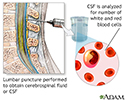CSF cell count
A CSF cell count is a test to measure the number of red and white blood cells that are in cerebrospinal fluid (CSF). CSF is a clear fluid that is in the space around the spinal cord and brain.
A lumbar puncture (spinal tap) is the most common way to collect this sample. Rarely, other methods are used for collecting CSF such as:
- Cisternal puncture
- Ventricular puncture
- Removal of CSF from a tube that is already in the CSF, such as a shunt or ventricular drain.
After the sample is taken, it is sent to a lab for evaluation.
Why the Test is Performed
The CSF cell count may help detect:
- Meningitis and infection of the brain or spinal cord
- Tumor, abscess, or area of tissue death (infarct)
- Inflammation
- Bleeding into the spinal fluid (secondary to subarachnoid hemorrhage)
Normal Results
The normal white blood cell count is between 0 and 5. The normal red blood cell count is 0.
Note: Normal value ranges may vary slightly among different laboratories. Talk to your doctor about the meaning of your specific test results.
The examples above show the common measurements for results for these tests. Some laboratories use different measurements or may test different specimens.
What Abnormal Results Mean
An increase of white blood cells indicates infection, inflammation, or bleeding into the cerebrospinal fluid. Some causes include:
- Abscess
- Encephalitis
- Hemorrhage
- Meningitis
- Multiple sclerosis
- Other infections
- Tumor
- Neurosarcoidosis
Finding red blood cells in the CSF may be a sign of bleeding. However, red blood cells in the CSF may also be due to the spinal tap needle hitting a blood vessel.
Additional conditions which this test may help diagnose include:
- Arteriovenous malformation (cerebral)
- Cerebral aneurysm
- Delirium
- Guillain-Barré syndrome
- Stroke
- Neurosyphilis
- Primary lymphoma of the brain
- Seizure disorders, including epilepsy
- Spinal tumor
References
Bergsneider M. Shunting. In: Winn HR, ed. Youmans and Winn Neurological Surgery. 7th ed. Philadelphia, PA: Elsevier; 2017:chap 31.
Deluca GC, Griggs RC. Approach to the patient with neurologic disease. In: Goldman L, Schafer AI, eds. Goldman-Cecil Medicine. 26th ed. Philadelphia, PA: Elsevier; 2020:chap 368.
Review Date: 5/4/2021
Reviewed By: Joseph V. Campellone, MD, Department of Neurology, Cooper Medical School at Rowan University, Camden, NJ. Review provided by VeriMed Healthcare Network. Also reviewed by David Zieve, MD, MHA, Medical Director, Brenda Conaway, Editorial Director, and the A.D.A.M. Editorial team.












